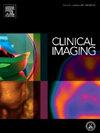影像学诊断为肺栓塞的男女长期死亡率
IF 1.8
4区 医学
Q3 RADIOLOGY, NUCLEAR MEDICINE & MEDICAL IMAGING
引用次数: 0
摘要
肺栓塞(PE)是一种严重程度不一的异质性疾病。风险因素和PE的发生因性别、年龄和合并症而异。我们的目的是确定影像学诊断为PE的男性和女性的长期死亡率,同时考虑到年龄和健康状况的差异。这是一项回顾性研究,在我们的多站点城市学术医疗中心进行了7年的成人PE通气/灌注显像或CT肺血管造影。回顾了电子健康记录(EHR)的患者数据,包括Charlson合并症指数(CCI)。一年死亡率由电子病历和国家死亡指数确定。使用Cox比例风险模型评估PE与生存率之间的关系。33,628例患者(55岁±19岁,69%为女性)接受了PE影像学检查,9.5%的检查结果为阳性。该队列的一年死亡率女性为9.9%,男性为16.8%,p <;0.001. 女性PE患者的1年死亡率高于男性PE患者(HR:1.38[1.21-1.58]) (HR: 2.75[2.48-3.06])。将年龄和CCI作为协变量纳入Cox比例风险模型后,女性PE患者的风险比也更高(女性HR 1.68[1.51-1.86],男性HR 1.20[1.05-1.36])。PE对女性死亡率的影响较大,导致女性和男性PE的一年死亡率相似,分别为21.9%和21.5% (P = 0.83)。阳性PE研究与一年死亡率显著增加相关,但这种影响在女性中更为明显。在考虑到年龄和合并症后,这种性别差异仍然存在。本文章由计算机程序翻译,如有差异,请以英文原文为准。
Long-term mortality from imaging-diagnosed pulmonary embolism in women and men
Pulmonary embolism (PE) is a heterogeneous disease with variable severity. Risk factors and occurrence of PE differ in patients by gender, age, and comorbidity. Our goal was to determine long-term mortality in imaging diagnosed PE in men and women while accounting for differences in age and health status.
This was a retrospective study of adults imaged for PE with ventilation/perfusion scintigraphy or CT pulmonary angiography over a 7-year period at our multisite urban academic medical center. Electronic health records (EHR) were reviewed for patient data, including Charlson comorbidity index (CCI). Mortality at one-year was determined from EHR and National Death Index. Association between PE and survival was assessed using Cox proportional hazard model.
33,628 patients (55yo ± 19, 69 % women) were imaged for PE, 9.5 % of exams were positive. One-year mortality for the cohort was 9.9 % for women vs. 16.8 % for men, p < 0.001. Women with PE had higher increased one-year mortality (HR 2.75[2.48–3.06]) than men with PE (HR:1.38[1.21–1.58]). Women with PE also had higher hazard ratio after inclusion of age and CCI as covariates in the Cox proportional hazard model (women HR 1.68 [1.51–1.86] versus men HR 1.20 [1.05–1.36]). The higher impact of PE on the mortality of women yielded a similar one-year mortality for women and men with PE, 21.9 % vs. 21.5 %, respectively (P = 0.83).
Positive PE study was associated with significantly increased one-year mortality, however this effect was much stronger in women. This gender difference persists after accounting for age and comorbidities.
求助全文
通过发布文献求助,成功后即可免费获取论文全文。
去求助
来源期刊

Clinical Imaging
医学-核医学
CiteScore
4.60
自引率
0.00%
发文量
265
审稿时长
35 days
期刊介绍:
The mission of Clinical Imaging is to publish, in a timely manner, the very best radiology research from the United States and around the world with special attention to the impact of medical imaging on patient care. The journal''s publications cover all imaging modalities, radiology issues related to patients, policy and practice improvements, and clinically-oriented imaging physics and informatics. The journal is a valuable resource for practicing radiologists, radiologists-in-training and other clinicians with an interest in imaging. Papers are carefully peer-reviewed and selected by our experienced subject editors who are leading experts spanning the range of imaging sub-specialties, which include:
-Body Imaging-
Breast Imaging-
Cardiothoracic Imaging-
Imaging Physics and Informatics-
Molecular Imaging and Nuclear Medicine-
Musculoskeletal and Emergency Imaging-
Neuroradiology-
Practice, Policy & Education-
Pediatric Imaging-
Vascular and Interventional Radiology
 求助内容:
求助内容: 应助结果提醒方式:
应助结果提醒方式:


